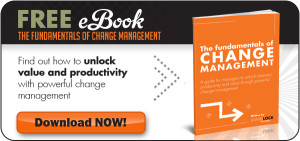When making a technology change, it is necessary to consider the impact of change on the human side and build a change management strategy which addresses this. This requires an effective change management approach which considers not only the impact on individuals and teams, but also how to convey the change and need for change before delivering the necessary ongoing support and training.
Here I look at how technology changes recommended by an external body were internally implemented by Ireland’s national rail company.
Keeping a change management strategy on track
In the late 1990s, Ireland’s rail transport provider, Iarnrod Eireann, was subject to an International Risk Management Services review which recommended the company centralise its fault management system. This would enable the company to better manage its maintenance program, reducing downtime for customers, improving network safety, and decreasing the negative impacts of a fractured fault management system. Station staff would receive fewer complaints, engineering staff would have less fragmentation of working practices, customers would benefit from an improved service, and the organisation’s financials would improve.
Having determined the case for change and put in place a team to implement the technical IAMS solution, board level executives at Iarnrod Eireann recognised the new technology would mean a large scale change to the way the company operated. This would impact how its employees interacted with each other. It simply wasn’t viable to implement the new technology without considering the human side of change.
Taking an unbiased view of change management
Iarnrod Eireann immediately hired external change consultants with particular expertise in the human side to help develop its change management strategy. The benefit of doing this was clear: the rail company had been operating for decades, and organisational culture was deeply ingrained. External consultants would not be clouded by any preconceived methodologies or ‘ways of doing things’. They would be able to work with the organisation to build out a change management strategy that would identify all stakeholders and design a framework for ongoing training to mitigate perceived negative impacts.
The three core elements of an effective change management strategy
Change management strategy requires the identification and examination of three core elements. A change management strategy which does not encompass these elements will ultimately fail. The consultants working with Iarnrod Eireaan first took time to identify all those that would be affected by the use of the new technology, before building upon the three core elements needed in the change management strategy:
-
Effective communication as a cornerstone of effective change management strategy
Having identified the stakeholders of change, the consultants worked with company management to establish the key messages required and the audiences to whom those key messages were to be communicated.
Benefits of the change were listed and communicated to each relevant audience group. This helped to establish areas of self-interests to which the change catered.
Communicating the change required a focussed approach, using a variety of tools. Email alone simply doesn’t work. Briefing packs were produced for use at presentations, posters on notice boards and a new intranet home page kept the change at the forefront of everyone’s thinking, and a section of the newsletter was handed over for regular and timely communications.
-
Assess impact of change before planning an effective change management strategy
Change will impact external stakeholders, internal stakeholders, and processes and working methods. This necessarily requires business decisions to be made. When these impacts are identified, only then can proper resource be allocated and a strategy put in place for coping with these impacts (which, of course, should include contingency planning).
-
Training planning and implementation as a foundation of an effective change management strategy
Having identified the stakeholders of change, how they are impacted as individuals and teams, and how and what to best communicate to them, the final essential element is training in the new practices, systems, and processes.
This requires identification of specific training needs, development of training schedules, and the design of delivery methods and scope.
Defining the benefits of a change management strategy
Having undertaken examination of the three core elements of a required change management strategy, only then can a change management plan be designed. The expertise provided by the external consultants achieved three major benefits:
- Stakeholders are communicated to effectively
Relevant information required by targeted users and others impacted by the change was communicated in the most effective way.
- Benefits to the self-interests of stakeholders identified and focussed
Effective communication led to better clarity of individual and team benefits. This aided in producing a single direction for all and cleared the path for the implementation team: dealing with objections before they happen lessens impact and means less ‘fire-fighting’.
- Organisational integration
By considering the human side of the change and the impacts of change across the organisation, Iarnrod Eireann was able to be certain that the systems implemented would be fully integrated and not seen as piecemeal solutions without a clear focus.
Diagnose the three core elements of change before designing change management strategy
By taking time to diagnose and understand organisation-wide requirements of the three core elements of change management strategy, and using external expertise to do so, the IAMS system was implemented and integrated across the rail network successfully.
The work the external consultants did as preparation for the design of a change management strategy ensured that the right information was delivered in the right way to the right people. Mechanisms for feedback were put in place, helping to engender a feeling of ownership of change.
After change management strategy had been defined, the external consultants then continued to work with Iarnrod Eireann to rollout the change management plan, supporting the implementation and integration of the new system and processes.

